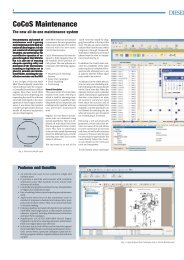LNG Carrier Propulsion by ME-GI Engines and/or Reliquefaction
LNG Carrier Propulsion by ME-GI Engines and/or Reliquefaction
LNG Carrier Propulsion by ME-GI Engines and/or Reliquefaction
You also want an ePaper? Increase the reach of your titles
YUMPU automatically turns print PDFs into web optimized ePapers that Google loves.
Engine Power f<strong>or</strong> <strong>LNG</strong> <strong>Carrier</strong>s<br />
Engine Power (kW)<br />
40<br />
30<br />
20<br />
125<br />
21 knots<br />
20 knots<br />
19 knots<br />
150 175 200<br />
Size (m3)<br />
Fig. 26: Typical propulsion power<br />
requirements f<strong>or</strong> <strong>LNG</strong> carriers<br />
Vibration levels are fully predictable <strong>and</strong><br />
controllable, both f<strong>or</strong> vessels with<br />
spherical tanks <strong>and</strong> membrane tank<br />
systems.<br />
Furtherm<strong>or</strong>e, the segregation of the gas<br />
cargo <strong>and</strong> heavy fuel f<strong>or</strong> propulsion ensured<br />
with reliquefaction means that<br />
h<strong>and</strong>ling of gas in the engine room <strong>and</strong><br />
surrounding areas is avoided.<br />
Based on the technology described in<br />
the f<strong>or</strong>egoing, the machinery to replace<br />
the steam turbine <strong>and</strong> boilers in a typical<br />
145,000 m 3 <strong>LNG</strong> carrier is theref<strong>or</strong>e 2 x<br />
approx. 20,000 hp low speed fuel burning<br />
<strong>ME</strong> <strong>or</strong> <strong>ME</strong>-<strong>GI</strong> type diesel engines.<br />
Typical propulsion power requirements<br />
f<strong>or</strong> <strong>LNG</strong> carriers of different sizes are<br />
shown in Fig. 26.<br />
The bridge <strong>and</strong> engine room control<br />
system shall be able to h<strong>and</strong>le operation<br />
with both one (emergency) <strong>and</strong> two<br />
engines.<br />
Load<br />
125%<br />
100%<br />
75%<br />
50%<br />
25%<br />
Propeller Perf<strong>or</strong>mance on Twin-Screw Vessel<br />
Heavier running, when only<br />
one propeller is in operation<br />
Single Engine Running Mode<br />
f<strong>or</strong> <strong>ME</strong>-<strong>Engines</strong><br />
Two propellers<br />
in operation<br />
50% 60% 70% 80% 90% 100% 110%<br />
Speed<br />
Fig. 27: Propeller curves in load diagram with one vs. two propellers w<strong>or</strong>king<br />
The bridge <strong>and</strong> engine room control<br />
system shall, in the case of operation<br />
on two engines, be able to h<strong>and</strong>le both<br />
individual control <strong>and</strong> simultaneous control<br />
of the engines.<br />
Simultaneous control consists of equality<br />
in power distribution, <strong>or</strong>der f<strong>or</strong> reversing,<br />
start of engines <strong>and</strong> stop of engines.<br />
The control system shall, in case of failure<br />
on one of the engines, be able to ensure<br />
continuous operation with only one engine<br />
without jeopardizing manoeuvrability <strong>or</strong><br />
safety of the ship <strong>or</strong> engines.<br />
In the case of FP propellers, it is presumed<br />
that, the shaft is declutched from the engines<br />
<strong>and</strong> the propeller wind- milling,<br />
alternatively that a shaft brake is applied.<br />
In the case of CP propellers, it is presumed<br />
that the propeller is at zero pitch<br />
<strong>and</strong> the shaft brake is active. If engine<br />
overhaul is to take place during sailing,<br />
declutching is necessary.<br />
In the case of a FP propelleer the w<strong>or</strong>king<br />
engine will have to accept a ‘heavy propeller’,<br />
i. e. higher t<strong>or</strong>que, as shown in<br />
Fig. 27, which basically calls f<strong>or</strong> a<br />
changed engine timing.<br />
With the <strong>ME</strong> engine concept, this can<br />
be done <strong>by</strong> push button only, activating<br />
“single engine running mode”.<br />
This can be pre-programmed into the<br />
software just as the so-called “economy<br />
mode” <strong>and</strong> “low NO x mode”. Hence,<br />
the operating engine of will be readily<br />
optimised f<strong>or</strong> the purpose, <strong>and</strong> full mobility<br />
of the vessel ensured.<br />
As per calculation, a speed of 75% of<br />
the design speed of the vessel can be<br />
obtained with a single engine in operation.<br />
19




